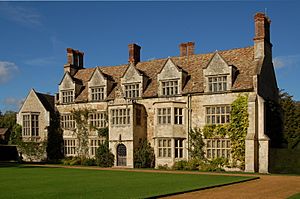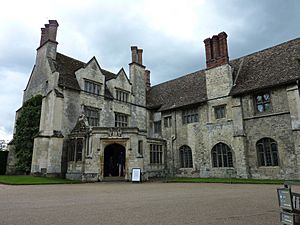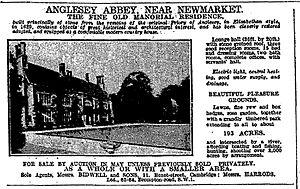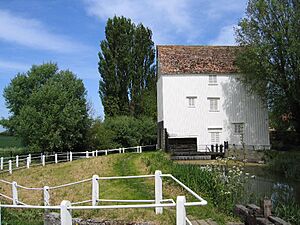Anglesey Abbey facts for kids
Anglesey Abbey is a special place in the village of Lode, about 9 km (5.5 miles) northeast of Cambridge, England. It's owned by the National Trust, which looks after historic places. The property includes a beautiful country house that was built on the remains of an old priory. It also has 98 acres (400,000 square meters) of amazing gardens and a working mill.
The priory was closed down in 1536 during a time called the Dissolution of the Monasteries. Around 1600, a Jacobean-style house was built where the priory used to be. Many different families owned the house over the years. The last private owner was Lord Fairhaven. He lived there from 1926 to 1966. He added a lot to the house to fit his huge collection of furniture, art, books, and other treasures. He also designed the beautiful gardens. When he passed away, he left Anglesey Abbey and everything inside it to the National Trust.
Contents
History of Anglesey Abbey
Anglesey Abbey started as an Augustinian priory, which is like a monastery for a specific group of monks. It was first set up as a hospital for St Mary between 1100 and 1135, during the time of King Henry I. Later, in 1212, it became a full priory.
In 1536, the priory was closed during the Dissolution of the Monasteries. This was when King Henry VIII closed down many monasteries in England. Three years later, the land was given to a lawyer named John Hynde. Most of the priory was taken apart, and its stones were used to build Madingley Hall.
The Fowkes family bought the property in 1595. They turned what was left of the priory into a Jacobean-style house. Parts of the old priory, like the walls of the chapter house (a meeting room for monks), became part of the new home.
Later owners included Thomas Hobson, who was famous for the saying "Hobson's Choice." The property was sometimes rented out as a farmhouse. By 1643, it was known as Anglesey Abbey, not Anglesey Priory.
In 1848, Reverend John Hailstone bought Anglesey Abbey. He was a vicar from a nearby village. He made some changes to the house and planted many trees along the drive, including cedars and wellingtonia. He lived there until he died in 1877. His widow sold it in 1888 to Reverend James George Clark, who lived there until 1912.
In 1926, two brothers, Urban Huttleston Broughton (who later became Lord Fairhaven) and Henry Rogers Broughton, bought Anglesey Abbey. They were very wealthy and loved horse racing, collecting art, and creating gardens. They made many changes to the house. For example, they turned the monks' old day room into a dining room.
Henry moved out in 1932, and Lord Fairhaven became the only owner. He added even more to the house to make space for his growing collections of books, paintings, and other treasures. He added a library wing in 1937 and a Tapestry Hall in 1939. In 1934, Lord Fairhaven also bought and fixed up Lode Mill, which is on the edge of the property. The mill had been built in the 1700s but was later used for grinding cement.
Lord Fairhaven also transformed the grounds around Anglesey Abbey. They used to be mostly fields, but he turned them into a beautiful park with tree-lined paths, flower gardens, statues, and decorations. The last part he added to the house was a two-story picture gallery, finished in 1956.
When Lord Fairhaven died in 1966, he left Anglesey Abbey to the National Trust. He wanted the house to stay exactly as it was, "a complete and furnished entity," so it would feel like a real English home.
Inside Anglesey Abbey
The house itself is special not just for its architecture, but for all the amazing things inside! Lord Fairhaven collected many different items, including furniture, paintings, sculptures, clocks, tapestries, and books. He had a unique taste and collected what he loved, not just what was popular.
Some of the rooms you can visit include:
- The living room, which was originally the chapter house of the priory and dates back to the 1200s.
- The "oak room" with its beautiful oak walls and a plaster ceiling copied from an old inn.
- The dining room, which used to be the monks' day room.
- The tapestry hall and the library, where some royal visitors even carved their names on a window!
- Several bedrooms upstairs and the two-story picture gallery.
The furniture includes a large Italian Renaissance table in the dining room and a white dressing table that once belonged to a famous actor named David Garrick. The library has bookshelves made from the old wooden supports of John Rennie's Waterloo Bridge in London! Lord Fairhaven also had tapestries, including one he asked a company to make, showing Anglesey Abbey and his family's coat-of-arms. There are many clocks in the house, including a tall, pagoda-shaped clock in the living room.
Lord Fairhaven loved British paintings, especially views of Windsor Castle, landscapes, and animal paintings. He collected over 750 paintings, prints, and drawings of Windsor Castle! He also had paintings by famous artists like John Constable and Thomas Gainsborough. While most art is British, there are also flower paintings by artists like Ambrosius Bosschaert and Jean-Baptiste de Fontenay. The collection also includes sculptures, like marble horses and a bronze bull.
The library at Anglesey Abbey holds almost 5,200 books. Most are regular reading books in fancy covers, but about a thousand are rare collector's books.
Gardens and Grounds
The 98 acres (400,000 square meters) of gardens at Anglesey Abbey are designed like an 18th-century park. Lord Fairhaven created many different areas, including tree-lined paths, open views, and flower gardens with classical statues.
He replanted the rose garden and created special gardens for dahlias, herbaceous plants, hyacinths, and narcissus (which has a statue of Narcissus in it). To celebrate the coronation of King George VI and Queen Elizabeth in 1937, Lord Fairhaven planted a long avenue of London plane and horse chestnut trees, similar to those in Windsor Great Park.
In front of the house, there's a formal lawn. Beyond that is a meadow where you can still see signs of old fishponds from the priory. This meadow is mown less often, allowing many wildflowers to grow, like bee orchids and pyramidal orchids. In summer, you can see lots of butterflies like meadow browns and gatekeepers.
A special Winter Garden was opened in 1998 to remember Lord Fairhaven. The head gardener, Richard Todd, received an award in 2013 for his many years of service to the gardens.
To the northwest of the house, some old farm buildings were turned into a large bungalow with a swimming pool. This was used as a Summer House by the Fairhaven family.
The grounds are bordered by a waterway called Bottisham Lode. At the end of it is Lode Mill, which Lord Fairhaven bought and restored in 1934. Near the mill is a large pool that is thought to be an old quarry from the 1800s.
Anglesey Abbey as a National Trust Property
Anglesey Abbey, also known as Anglesey Abbey, Gardens and Lode Mill, is usually open to the public all year round. There's an admission fee, but National Trust members can enter for free. It's a very popular place, with hundreds of thousands of visitors each year.
In 1978, Lode Mill was fixed up to work again by a local society, and you can even buy flour made at the mill! A new visitor center with a restaurant and shop opened in 2008. Anglesey Abbey also hosts fun seasonal events like a winter lights festival, snowdrop walks, and outdoor cinema in the summer.
In March 2020, the property had to close temporarily because of the COVID-19 pandemic, but the gardens and park reopened a few months later.
Anglesey Abbey was mentioned in a National Trust report because one of its past owners, Samuel Shepheard, who bought the property in 1739, was involved with a large trading company called the East India Company in the early 1700s.
Images for kids













